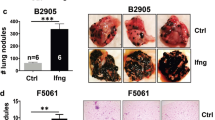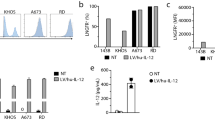Abstract
Interferons (IFNs) have been investigated as important cytokines in immunotherapy. The use of IFNs in cancer immunotherapy has had limited success. In this study, IFN genes were delivered into B16 melanoma cells by lentiviral vectors, and their effects on B16 melanoma were comprehensively analyzed. Type II IFN significantly impaired the viability of B16 cells in vitro. Expression of IFNα and IFNβ in B16 cells efficiently suppressed the establishment of inoculated melanoma. However, intratumoral delivery of IFNs alone with lentiviral vectors had no therapeutic effects on established melanoma. To address the lack of response, a lentivector was constructed to simultaneously transfer therapeutic genes and small interfering RNAs (siRNAs). IFNs and siRNA targeting signal transducer and activator of transcription 3 (STAT3), which is a major immune suppressive transcription factor in melanoma, were delivered simultaneously into the tumor milieu. This treatment successfully rescued the response to IFNγ and attenuated the growth of established tumors. This method has the potential to improve the therapeutic effects of IFNs in cancer immunotherapy.
This is a preview of subscription content, access via your institution
Access options
Subscribe to this journal
Receive 12 print issues and online access
$259.00 per year
only $21.58 per issue
Buy this article
- Purchase on Springer Link
- Instant access to full article PDF
Prices may be subject to local taxes which are calculated during checkout





Similar content being viewed by others
References
Schreiber RD, Old LJ, Smyth MJ . Cancer immunoediting: integrating immunity’s roles in cancer suppression and promotion. Science 2011; 331: 1565–1570.
Rosenberg SA . Raising the bar: the curative potential of human cancer immunotherapy. Sci Transl Med 2012; 4: 127ps8.
Dunn GP, Bruce AT, Sheehan KC, Shankaran V, Uppaluri R, Bui JD et al. A critical function for type I interferons in cancer immunoediting. Nat Immunol 2005; 6: 722–729.
Gao Y, Yang W, Pan M, Scully E, Girardi M, Augenlicht LH et al. Gamma delta T cells provide an early source of interferon gamma in tumor immunity. J Exp Med 2003; 198: 433–442.
Kaplan DH, Shankaran V, Dighe AS, Stockert E, Aguet M, Old LJ et al. Demonstration of an interferon gamma-dependent tumor surveillance system in immunocompetent mice. Proc Natl Acad Sci USA 1998; 95: 7556–7561.
Dunn GP, Koebel CM, Schreiber RD . Interferons, immunity and cancer immunoediting. Nat Rev Immunol 2006; 6: 836–848.
Wang BX, Rahbar R, Fish EN . Interferon: current status and future prospects in cancer therapy. J Interferon Cytokine Res 2011; 31: 545–552.
Bowman T, Broome MA, Sinibaldi D, Wharton W, Pledger WJ, Sedivy JM et al. Stat3-mediated Myc expression is required for Src transformation and PDGF-induced mitogenesis. Proc Natl Acad Sci USA 2001; 98: 7319–7324.
Gritsko T, Williams A, Turkson J, Kaneko S, Bowman T, Huang M et al. Persistent activation of stat3 signaling induces survivin gene expression and confers resistance to apoptosis in human breast cancer cells. Clin Cancer Res 2006; 12: 11–19.
Niu G, Wright KL, Huang M, Song L, Haura E, Turkson J et al. Constitutive Stat3 activity up-regulates VEGF expression and tumor angiogenesis. Oncogene 2002; 21: 2000–2008.
Wang T, Niu G, Kortylewski M, Burdelya L, Shain K, Zhang S et al. Regulation of the innate and adaptive immune responses by Stat-3 signaling in tumor cells. Nat Med 2004; 10: 48–54.
Yu H, Kortylewski M, Pardoll D . Crosstalk between cancer and immune cells: role of STAT3 in the tumour microenvironment. Nat Rev Immunol 2007; 7: 41–51.
Kortylewski M, Kujawski M, Wang T, Wei S, Zhang S, Pilon-Thomas S et al. Inhibiting Stat3 signaling in the hematopoietic system elicits multicomponent antitumor immunity. Nat Med 2005; 11: 1314–1321.
Kasprzycka M, Marzec M, Liu X, Zhang Q, Wasik MA . Nucleophosmin/anaplastic lymphoma kinase (NPM/ALK) oncoprotein induces the T regulatory cell phenotype by activating STAT3. Proc Natl Acad Sci USA 2006; 103: 9964–9969.
Kong LY, Gelbard A, Wei J, Reina-Ortiz C, Wang Y, Yang EC et al. Inhibition of p-STAT3 enhances IFN-alpha efficacy against metastatic melanoma in a murine model. Clin Cancer Res 2010; 16: 2550–2561.
Escors D, Breckpot K . Lentiviral vectors in gene therapy: their current status and future potential. Arch Immunol Ther Exp (Warsz) 2010; 58: 107–119.
Cartier N, Hacein-Bey-Abina S, Bartholomae CC, Veres G, Schmidt M, Kutschera I et al. Hematopoietic stem cell gene therapy with a lentiviral vector in X-linked adrenoleukodystrophy. Science 2009; 326: 818–823.
Esslinger C, Chapatte L, Finke D, Miconnet I, Guillaume P, Levy F et al. In vivo administration of a lentiviral vaccine targets DCs and induces efficient CD8(+) T cell responses. J Clin Invest 2003; 111: 1673–1681.
Rowe HM, Lopes L, Ikeda Y, Bailey R, Barde I, Zenke M et al. Immunization with a lentiviral vector stimulates both CD4 and CD8 T cell responses to an ovalbumin transgene. Mol Ther 2006; 13: 310–319.
Kutner RH, Zhang XY, Reiser J . Production, concentration and titration of pseudotyped HIV-1-based lentiviral vectors. Nat Protoc 2009; 4: 495–505.
Hanahan D, Weinberg RA . Hallmarks of cancer: the next generation. Cell 2011; 144: 646–674.
Street SE, Cretney E, Smyth MJ . Perforin and interferon-gamma activities independently control tumor initiation, growth, and metastasis. Blood 2001; 97: 192–197.
Mitra-Kaushik S, Harding J, Hess J, Schreiber R, Ratner L . Enhanced tumorigenesis in HTLV-1 tax-transgenic mice deficient in interferon-gamma. Blood 2004; 104: 3305–3311.
Shankaran V, Ikeda H, Bruce AT, White JM, Swanson PE, Old LJ et al. IFNgamma and lymphocytes prevent primary tumour development and shape tumour immunogenicity. Nature 2001; 410: 1107–1111.
Passalacqua R, Buzio C, Buti S, Porta C, Labianca R, Pezzuolo D et al. Phase III, randomised, multicentre trial of maintenance immunotherapy with low-dose interleukin-2 and interferon-alpha for metastatic renal cell cancer. Cancer Immunol Immunother 2010; 59: 553–561.
Kirkwood J . Cancer immunotherapy: the interferon-alpha experience. Semin Oncol 2002; 29 (3 Suppl 7): 18–26.
Gleave ME, Elhilali M, Fradet Y, Davis I, Venner P, Saad F et al. Interferon gamma-1b compared with placebo in metastatic renal-cell carcinoma. Canadian Urologic Oncology Group. N Engl J Med 1998; 338: 1265–1271.
Wiesenfeld M, O'Connell MJ, Wieand HS, Gonchoroff NJ, Donohue JH, Fitzgibbons RJ et al. Controlled clinical trial of interferon-gamma as postoperative surgical adjuvant therapy for colon cancer. J Clin Oncol 1995; 13: 2324–2329.
Lu W, Fidler IJ, Dong Z . Eradication of primary murine fibrosarcomas and induction of systemic immunity by adenovirus-mediated interferon beta gene therapy. Cancer Res 1999; 59: 5202–5208.
Jonasch E, Haluska FG . Interferon in oncological practice: review of interferon biology, clinical applications, and toxicities. Oncologist 2001; 6: 34–55.
He Y, Zhang J, Donahue C, Falo LD . Skin-derived dendritic cells induce potent CD8(+) T cell immunity in recombinant lentivector-mediated genetic immunization. Immunity 2006; 24: 643–656.
Stegmeier F, Hu G, Rickles RJ, Hannon GJ, Elledge SJ . A lentiviral microRNA-based system for single-copy polymerase II-regulated RNA interference in mammalian cells. Proc Natl Acad Sci USA 2005; 102: 13212–13217.
Shin KJ, Wall EA, Zavzavadjian JR, Santat LA, Liu J, Hwang JI et al. A single lentiviral vector platform for microRNA-based conditional RNA interference and coordinated transgene expression. Proc Natl Acad Sci USA 2006; 103: 13759–13764.
De Palma M, Mazzieri R, Politi LS, Pucci F, Zonari E, Sitia G et al. Tumor-targeted interferon-alpha delivery by Tie2-expressing monocytes inhibits tumor growth and metastasis. Cancer Cell 2008; 14: 299–311.
Liu P, Zhang C, Chen J, Zhang R, Ren J, Huang Y et al. Combinational therapy of interferon-alpha and chemotherapy normalizes tumor vasculature by regulating pericytes including the novel marker RGS5 in melanoma. J Immunother 2011; 34: 320–326.
Sundstedt A, Celander M, Hedlund G . Combining tumor-targeted superantigens with interferon-alpha results in synergistic anti-tumor effects. Int Immunopharmacol 2008; 8: 442–452.
Brown L, Roda J, Terrell C, Chaudhury AR, Crespin T, Carson WE et al. Interferon alpha and CPG oligodeoxynucleotides elicit additive immunostimulatory and antitumor effects. Surgery 2006; 140: 297–306.
Zaidi MR, Davis S, Noonan FP, Graff-Cherry C, Hawley TS, Walker RL et al. Interferon-gamma links ultraviolet radiation to melanomagenesis in mice. Nature 2011; 469: 548–553.
He YF, Wang XH, Zhang GM, Chen HT, Zhang H, Feng ZH . Sustained low-level expression of interferon-gamma promotes tumor development: potential insights in tumor prevention and tumor immunotherapy. Cancer Immunol Immunother 2005; 54: 891–897.
Acknowledgements
We thank SJ Elledge for kindly providing plasmid pPRIME-CMV-GFP. This work was supported by National Science Foundation of China (30800273, 30901389).
Author information
Authors and Affiliations
Corresponding author
Ethics declarations
Competing interests
The authors declare no conflict of interest.
Rights and permissions
About this article
Cite this article
Wang, X., Liu, P., Liu, H. et al. Delivery of interferons and siRNA targeting STAT3 using lentiviral vectors suppresses the growth of murine melanoma. Cancer Gene Ther 19, 822–827 (2012). https://doi.org/10.1038/cgt.2012.65
Received:
Revised:
Accepted:
Published:
Issue Date:
DOI: https://doi.org/10.1038/cgt.2012.65
Keywords
This article is cited by
-
Involvement of early growth response factors in TNFα-induced aromatase expression in breast adipose
Breast Cancer Research and Treatment (2013)



